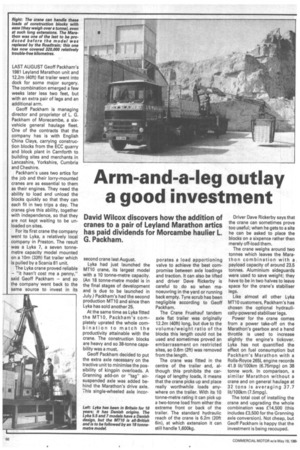Arm-and-a-leg outlay a good investment
Page 84

If you've noticed an error in this article please click here to report it so we can fix it.
David Wilcox discovers how the addition of cranes to a pair of Leyland Marathon attics has paid dividends for Morcambe haulier L G. Packham.
LAST AUGUST Geoff Packham's 1981 Leyland Marathon unit and 12.2m (40ft) flat trailer went into dock for some major surgery. The combination emerged a few weeks later less two feet, but with an extra pair of legs and an additional arm.
Geoff Packham is managing director and proprietor of L. G. Packham of Morecambe, a sixvehicle general haulage fleet. One of the contracts that the company has is with English China Clays, carrying construction blocks from the ECC quarry and block plant in Carnforth to building sites and merchants in Lancashire, Yorkshire, Cumbria and Cheshire.
Packham's uses two artics for the job and their lorry-mounted cranes are as essential to them as their engines. They need the ability to load and unload the blocks quickly so that they can each fit in two trips a day. The cranes give this ability, together with independence, so that they are not kept waiting to be unloaded on sites.
For its first crane the company went to Lyka, a relatively local company in Preston. The result was a Lyka 7, a seven tonnemetre capacity model mounted on a 10m (33ft) flat trailer which is pulled by a Scania 81 unit.
The Lyka crane proved reliable — "it hasn't cost me a penny," said Geoff Packham — and so the company went back to the same source to invest in its second crane last August.
Lyka had just launched the MT10 crane, its largest model with a 10 tonne-metre capacity. (An 18 tonne-metre model is in the final stages of development and is due to be launched in July.) Packham's had the second production MT10 and since then Lyka has sold another 25.
At the same time as Lyka fitted the MT10, Packham's completely uprated the whole combination to match the productivity attainable with the crane. The construction blocks are heavy and so 38-tonne capability was a must.
Geoff Packham decided to put the extra axle necessary on the tractive unit to minimise the possibility of kingpin overloads. A Granning add-on or "tag" airsuspended axle was added behind the Marathon's drive axle. This single-wheeled axle incor porates a load apportioning valve to achieve the best compromise between axle loadings and traction. It can also be lifted and driver Dave Rickerby is careful to do so when manoeuvring in the yard or running back empty. Tyre scrub has been negligible according to Geoff Packham.
The Crane Fruehauf tandem axle flat trailer was originally 12.2m (40ft) long, but due to the volume/weight ratio of the blocks this length could not be used and sometimes proved an embarrassment on restricted sites, so 0.6m (2ft) was removed from the length.
The crane was fitted in the centre of the trailer and, although this prohibits the carriage of lengthy loads, it means that the crane picks up and place really worthwhile loads anywhere on the trailer. With its 10 tonne-metre rating it can pick up a two-tonne load from either the extreme front or back of the trailer. The standard hydraulic reach of the crane is 6.2m (20ft 6in), at which extension it can still handle 1,600kg. Driver Dave Rickerby says that the crane can sometimes prove too useful; when he gets to a site he can be asked to place the blocks on a sixpence rather then merely off-load them.
The crane weighs around two tonnes which leaves the Marathon combination with a payload capacity of around 23.5 tonnes. Aluminium sideguards were used to save weight; they have to be in two halves to leave space for the crane's stabiliser legs.
Like almost all other Lyka MT10 customers, Packham's has chosen the optional hydraulically-powered stabiliser legs.
Power for the crane comes from a power take-off on the Marathon's gearbox and a hand throttle is used to increase slightly the engine's tickover. Lyka has not quantified the effect on fuel consumption but Packham's Marathon with a Rolls-Royce 265L engine records 41.9 lit/100km (6.75mpg) on 38 tonne work. In comparison, a similar Marathon without a crane and on general haulage at 32 tons is averaging 37.7 lit/100km (7.5mpg).
The total cost of installing the crane and upgrading the whole combination was £14,500 (this includes £3,500 for the Granning axle conversion). Not cheap, but Geoff Packham is happy that the investment is being recouped.
























































































































